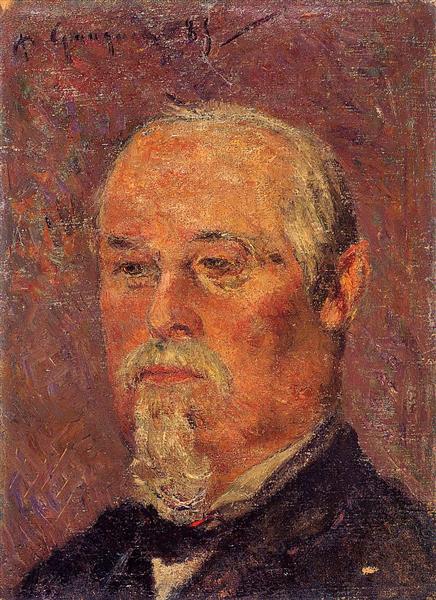Description
The painting "Portrait of Filiberto Favre" from 1885, by the post-impressionist master Paul Gauguin, stands as a testimony to the psychological and emotional depth that the artist was able to bring to his work. In the portrait, Filiberto Favre, a friend and fellow artist of Gauguin, is represented in a way that transcends the merely physical; it is an inquiry into the essence of being, into the human capacity to communicate not only appearance, but also interiority.
From the first glance, the composition reveals a remarkable use of space and form. Favre is positioned in the centre of the canvas, his figure becoming the core of the work. With a relaxed but slightly turned posture, a visual connection is established with the viewer, suggesting a silent conversation that transcends the frame of time. This compositional device provokes in the observer a feeling of intimacy, almost as if a private moment is interrupted to be shared.
Colour plays a fundamental role in this work. Gauguin uses a palette that, although relatively restrained compared to his later works, is characterised by a harmony that highlights the humanity of the subject. Warm, earthy tones predominate in the hues of Favre's skin, suggesting a living materiality, while the background is a cooler shade of blue that contrasts effectively with the sitter, elevating the figure and focusing attention on his face and expression. This choice of colours can be interpreted as a reflection of the friendship and affection that Gauguin felt towards his sitter.
Favre's face is exceptionally expressive. Gauguin, often critical of the Impressionist technique that employed vibrant colours and rapid brushstrokes, here shows his mastery in creating more subtle atmospheres. Filiberto's gaze is introspective and melancholic, and the facial features are rendered with a care that gives them emotional depth. There is a certain sadness in his eyes, which evoke reflections on life, friendship and the artist's struggle.
Gauguin's work is in many ways a bridge between Impressionism and Symbolism, anticipating a turn in his career toward bolder explorations in Tahiti. Although Portrait of Filiberto Favre is set in what some consider a more classical period in his career, it nonetheless demonstrates his interest in more universal aspects of human beings. In the same way, this work resonates with other contemporary portraits by artists such as Vincent van Gogh, in which emotions and individuality are rendered in a visceral way.
The creation of this portrait can also be seen as a moment of personal reflection for Gauguin, who was exploring his own identity and his place in the changing art landscape of the time. This portrait not only captures a friend, but also reveals a bit of Gauguin's own soul, making it an extremely valuable work both historically and emotionally.
In short, Portrait of Filiberto Favre is more than just a portrait. It is a work that defies time and convention, inviting the viewer into the psyche of its subject and of Gauguin himself. Its refined composition, emotional palette, and depth of expression of the subject place it as a jewel in the repertoire of post-impressionist art, a reminder of the human complexity that can be captured through the brush of a master.
KUADROS ©, a famous painting on your wall.
Hand-made oil painting reproductions, with the quality of professional artists and the distinctive seal of KUADROS ©.
Painting reproduction service with satisfaction guarantee. If you are not completely satisfied with the replica of your painting, we will refund 100% of your money.

